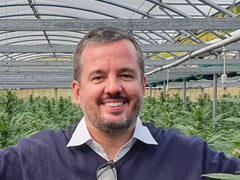Cannabis indica has always stood out to me, not just because of how it looks, but because of the role it plays in shaping how we grow and work with hemp today. I’ve spent a lot of time with this variety, both in research and on the production side, and I’ve seen up close how its unique traits continue to influence modern cultivation and breeding.
After more than a decade in the cannabis industry, I’ve learned to notice the small but important differences between the plant’s various types. Indica, in particular, keeps showing up as a key player in everything from field practices to genetic planning.
In this article, I want to share some of what I’ve learned over the years, specifically about what sets Cannabis indica apart. Whether it’s how it grows or the practical advantages it brings to hemp farming, the goal is to offer a clear, down-to-earth look at a plant that’s often mentioned, but not always deeply understood.
Prefer watching over reading? This video covers the key points from the article:
Save up to 30% when you order your CBD oil today
Key takeaways
- Cannabis indica is a subspecies of the cannabis plant that originated in the Hindu Kush mountain region.
- It typically grows shorter and bushier than other types of cannabis plants.
- The plant produces dense buds with a high amount of resin.
- It is often used in breeding to create hybrid strains with specific physical traits.
- Cannabis indica grows well in cooler climates and is commonly cultivated indoors.
This article is provided for informational purposes only and does not relate to any of the products available in our webshop. For more information, please see our full disclaimer.
Introduction to Cannabis indica
Cannabis indica holds a special place among cultivated plants due to its historical significance and distinctive characteristics. According to a journal published in PhytoKeys, it originated in the arid, mountainous regions of Afghanistan, Pakistan, and northern India, particularly near the Hindu Kush range.
Indica plants developed a compact structure and broad leaves. These features helped them conserve water and withstand the climate’s extremes. This resilience is a reflection of both the plant’s natural hardiness and the traditional growing practices passed down through generations.

The history of Cannabis indica is deeply tied to the people and cultures that cultivated it. Its long-standing presence in these areas points to a longstanding relationship between human stewardship and environmental adaptation.
Defining characteristics
Cannabis indica differs notably from sativa varieties. It features broad, wide leaves and a compact growth habit, staying low to the ground, unlike the taller, slender sativa plants. These traits allow indica to thrive in cooler climates with shorter growing seasons, making it well-suited for regions with similar conditions.
Understanding Cannabis indica not only deepens appreciation for the plant but also supports more effective cultivation and application across various settings.
The botanical profile of Cannabis indica
Indica plants are well-suited to challenging climates. Their short, bushy structure and broad leaves help them grow efficiently in cooler regions. The large, dark green leaves contain high levels of chlorophyll, supporting effective photosynthesis even in low light.
Their compact form is not only an adaptation for survival but also makes them ideal for cultivation in limited spaces. This trait is particularly useful in areas with space constraints or for indoor growing.
The dense build of indica plants is also valuable to breeders. It serves as a foundation for developing strains with specific characteristics, contributing to their wide range of applications.
Understanding these features offers insight into why indica varieties are commonly cultivated in both natural and controlled environments. Their form and function reflect a plant shaped by, and responsive to, its surroundings.
Indica vs. Sativa: Understanding the differences
The comparison between indica and sativa centres on their distinct traits, which influence cultivation methods, medical applications, and user preferences. These differences begin with physical appearance and extend to their chemical profiles, shaping how each type is used and valued.

Physical attributes
Indica plants are short, dense, and bushy, rarely exceeding 2 meters in height. Their broad, dark green leaves reflect their origins in the harsh, mountainous regions of the Hindu Kush. In contrast, sativa plants grow taller and more slender, often reaching up to 3 meters, with narrow leaves suited to warm, humid climates.
Terpenes over Sativa and Indica
A study in Natural Products Chemistry & Research found that the labels Cannabis sativa and Cannabis indica do not reliably reflect chemical differences, but terpene profiles show consistent patterns among different strains.
| Strain grouping | Common association | Dominant terpenes |
|---|---|---|
| Kush-type strains | Indica-dominant | • β-myrcene • α-pinene • trans-β-ocimene • guaiol • β-eudesmol |
| OG-type strains | Sativa-dominant | • α-terpineol • limonene • camphene • terpinolene • linalool |
Cultivation of Cannabis indica
Exploring cannabis farming, I find growing indica fascinating and challenging. The right climate is key to its growth and yield. Indica loves cooler weather, making it perfect for certain places.
Knowing the ideal climate is crucial for growing indica. These plants do well in mild temperatures. This helps them grow dense buds. The right climate often decides where indica is grown worldwide.

Preferred climate and conditions
Indica comes from the cold Hindu Kush mountains. They can handle a wide range of temperatures. This makes them great for cooler places, where their buds grow well without getting too hot.
Common challenges in growing
Indica plants are tough but face some issues. According to research published in Frontiers in Microbiology, Indica-dominant cannabis plants, while robust in structure, tend to produce dense inflorescences with a high number of broad leaves.
These thick leaf clusters can retain excess moisture within the plant canopy, especially under warm and humid conditions.
This creates a microclimate that promotes the growth of mould and fungal pathogens such as Aspergillus, Penicillium, and Fusarium, making these genotypes more susceptible to microbial contamination and post-harvest spoilage. Good farming means watching moisture and air flow to keep plants healthy.
- Regularly monitor moisture levels within plant foliage.
- Ensure proper ventilation to prevent the accumulation of excess moisture.
- Implement pest management strategies tailored to the dense growth habit of indica plants.
Through my own experience and talking to experts, I've learned a lot. Growing indica well means knowing its needs and the challenges it faces. This knowledge helps improve the quality and amount of what's grown.
Order and enjoy up to 30% off your CBD oil purchase
Hybrid strains: Combining the best of Indica and Sativa
The world of hybrid cannabis strains is fascinating. It reflects the careful breeding and selection that define modern cannabis cultivation.
By combining characteristics of both Indica and Sativa, growers create unique strains that showcase qualities from each variety. Whether leaning more towards Indica or Sativa, each hybrid represents a thoughtful balance of its genetic background.
Creation of hybrids
Making hybrids is a careful and selective process. It brings together key features from both Indica and Sativa varieties. The aim is to combine Indica's sturdy, compact structure with the growth traits more typical of Sativa.

Growers select parent strains based on observable characteristics such as plant size, flowering time, aroma, and cannabinoid composition. Through controlled breeding, they produce hybrids that reflect specific qualities drawn from each type. This method relies on precision, patience, and a solid understanding of cannabis genetics.
| Hybrid name | Characteristics | Terpene |
|---|---|---|
| Pink Runtz | Sweet fruity aroma with a creamy finish | Limonene |
| Biscotti | Rich aroma of sweet cookies with hints of diesel | Caryophyllene |
| Gelato | Dessert-like scent with notes of berries and citrus | Myrcene |
| Wedding Cake | Earthy and doughy scent with mild vanilla tones | Limonene |
| Animal Mints | Blend of mint, pine, and cookie-like aroma | Pinene |
Order and enjoy up to 30% off your CBD oil purchase
Future of Cannabis indica
Interest in Cannabis indica continues to grow, particularly due to recent progress in farming methods and plant genetics. These developments are leading to more refined and diverse strains.
The direction is toward creating plants with particular profiles that meet different preferences while maintaining quality and relevance in a changing environment.
Shifts in legislation across various regions have contributed to increased investment in the cannabis field. This has supported further research and refinement of Cannabis indica varieties.
Modern indoor cultivation methods are gaining traction, offering greater control over growing conditions and improving efficiency with attention to environmental impact.

Breeders are focusing on tailoring characteristics of Cannabis indica, such as aroma, growth cycle, and physical effects. This targeted development aligns with the interests of different users, from those involved in technical horticulture to those interested in its broader applications.
Looking ahead, Cannabis indica is expected to play a growing part in both research and cultivation practices. As it gains wider acceptance, there will likely be continued interest in how it can be refined and adapted to suit different uses and preferences. This period marks a productive phase for professionals and enthusiasts working with the plant.
Personal perspective
I have worked closely with Cannabis indica across many seasons and settings, and its reliability under pressure remains one of its most practical strengths. Its compact shape, quick flowering cycle, and dense structure have consistently proven useful in controlled environments and smaller-scale farming.
Over the years, I’ve come to appreciate not just how it grows, but how it responds to different challenges, from temperature swings to limited space. These traits continue to make it a preferred option in breeding work, where physical consistency and resilience are valuable assets.
In my own experience, indica-dominant cultivars often provide the kind of structure and growth behaviour that help streamline production, especially when consistency and space efficiency matter. Whether used in hybrid development or selected for its form, indica remains a dependable choice in modern cultivation.
Don’t miss out—save up to 30% when you purchase CBD oil today
Frequently asked questions
What is Cannabis indica?
Cannabis indica is a type of cannabis plant. It originates from regions such as Afghanistan, Pakistan, and India. It is recognised for its broad leaves and compact growth pattern.
Indica strains differ from Cannabis sativa in appearance and are widely appreciated for various purposes.
What are the origins and history of Cannabis indica?
Cannabis indica comes from the Hindu Kush mountains in Afghanistan, Pakistan, and India. It developed resilience in cold climates and adapted to shorter growing seasons.
What are the defining characteristics of Cannabis indica?
Cannabis indica appears sturdy and bushy. It has dense foliage and tends to be shorter than Cannabis sativa. Its leaves are a deeper green due to higher chlorophyll content.
What is the botanical profile of Cannabis indica?
Cannabis indica has a robust structure with tightly packed leaves. It is naturally suited for colder climates and displays physical traits that support resilience.
How do Cannabis indica and sativa differ physically?
Cannabis indica is shorter and bushier, with broader leaves. Cannabis sativa, on the other hand, is taller and has narrower leaves. These differences influence their growth behaviour and environmental preferences.
What is the chemical composition of Cannabis indica in comparison to sativa?
Indica strains generally exhibit higher levels of THC relative to CBD, whereas sativa strains are often associated with a different cannabinoid profile. These differences influence how the plant is used in various contexts.
What are the preferred climate and conditions for cultivating Cannabis indica?
Cannabis indica performs well in cooler climates. It tolerates temperature fluctuations and grows best in ventilated spaces that reduce the risk of mould and pests.
What are some common challenges in growing Cannabis indica?
One challenge in growing Cannabis indica is managing moisture around its dense leaves, which can lead to mould or pest problems. Proper airflow and humidity control are essential for healthy development.
What levels of THC and CBD can be found in Indica strains?
Indica strains typically feature THC levels ranging from 18% to 21%, with some reaching up to 25%. They tend to have lower CBD levels in comparison.
Which are some popular Indica strains and their properties?
Pink Rozay and Oreo are well-known indica strains. They are notable for their aromatic profiles and physical effects, making them popular in cultivation and recreational settings.
How are hybrid strains created?
Hybrid strains result from crossbreeding indica and sativa varieties. The goal is to combine qualities from both types, such as indica’s physical traits with sativa’s growth characteristics, creating a balanced outcome.
Can you give examples of famous hybrid strains?
Pink Runtz and Biscotti are notable hybrid strains. They combine elements from both indica and sativa, offering distinctive features in growth and aroma.
How should one go about choosing the right Indica strain?
Selecting an indica strain depends on several factors, including strength, aroma, and whether a pure or hybrid type is preferred. Consulting knowledgeable professionals can help guide the decision.
How can Cannabis indica be used in culinary applications?
Cannabis indica can be incorporated into culinary settings where its use is accepted. Any inclusion in food preparation must align with local practices and avoid any restricted applications.
What does the future hold for Cannabis indica in terms of trends and innovations?
The future of Cannabis indica includes new approaches in genetics and sustainable cultivation. As laws evolve and knowledge grows, more refined and varied strains are expected to appear, supporting both cultivation and breeding efforts.






